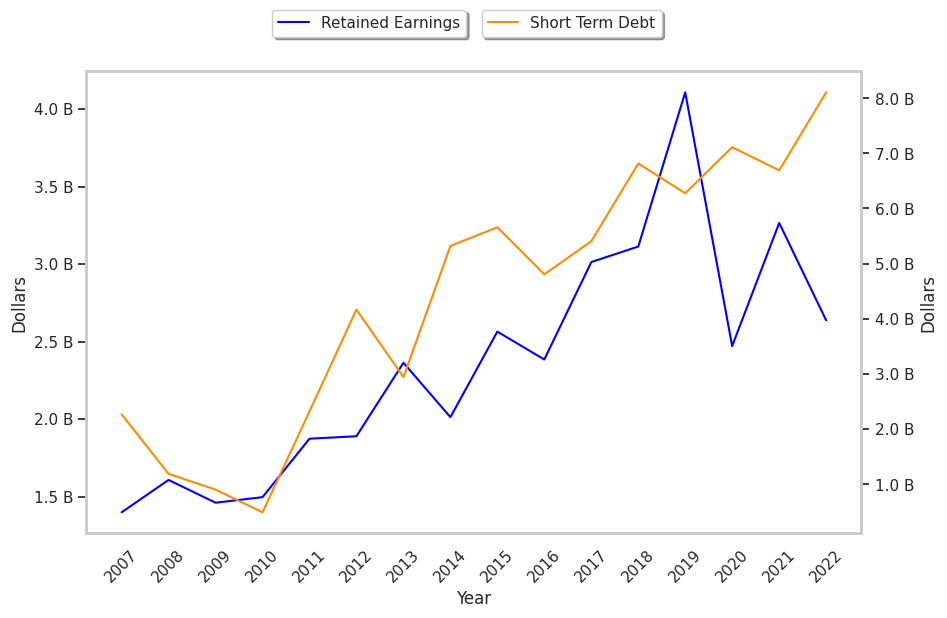Now trading at a price of $88.16, Duke Energy has moved -0.2% so far today.
Duke Energy returned losses of -7.0% last year, with its stock price reaching a high of $106.43 and a low of $83.06. Over the same period, the stock underperformed the S&P 500 index by -18.0%. As of April 2023, the company's 50-day average price was $89.57. Duke Energy Corporation, together with its subsidiaries, operates as an energy company in the United States. Based in Charlotte, NC, the large-cap Utilities company has 27,859 full time employees. Duke Energy has returned a 4.6% dividend yield over the last 12 months, but this may not be sustainable seen that the company has a choppy cash flow record.
The Company May Be Profitable, but Its Balance Sheet Is Highly Leveraged:
| 2018 | 2019 | 2020 | 2021 | 2022 | 2023 | |
|---|---|---|---|---|---|---|
| Revenue (MM) | $24,521 | $25,079 | $23,366 | $24,621 | $28,768 | $29,047 |
| Gross Margins | 19% | 23% | 20% | 22% | 21% | 22% |
| Operating Margins | 19.0% | 23.0% | 20.0% | 22.0% | 21.0% | 22.0% |
| Net Margins | 11.0% | 15.0% | 6.0% | 16.0% | 13.0% | 13.0% |
| Net Income (MM) | $2,666 | $3,748 | $1,377 | $3,908 | $3,778 | $3,766 |
| Net Interest Expense (MM) | $2,094 | $2,204 | $2,097 | $2,207 | $2,439 | $2,729 |
| Depreciation & Amort. (MM) | $4,696 | $5,176 | $5,486 | $5,663 | $5,843 | $5,836 |
| Earnings Per Share | $3.77 | $5.14 | $1.87 | $5.08 | $4.91 | $4.88 |
| Diluted Shares (MM) | 708 | 729 | 738 | 769 | 770 | 771 |
| Free Cash Flow (MM) | -$2,203 | -$2,913 | -$1,051 | -$1,425 | -$5,440 | -$6,838 |
| Capital Expenditures (MM) | $9,389 | $11,122 | $9,907 | $9,715 | $11,367 | $12,515 |
| Net Current Assets (MM) | -$29,529 | -$34,667 | -$36,709 | -$33,154 | -$34,233 | -$32,655 |
| Long Term Debt (MM) | $51,123 | $54,985 | $55,625 | $60,448 | $65,873 | $69,914 |
| Net Debt / EBITDA | 5.42 | 4.84 | 5.27 | 5.01 | 5.39 | 5.54 |
Duke Energy has weak revenue growth and increasing reinvestment in the business, decent operating margins with a stable trend, and positive EPS growth. However, Duke Energy has slimmer gross margins than its peers, an unconvincing cash flow history, and a highly leveraged balance sheet.
Duke Energy's Valuation Is in Line With Its Sector Averages:
Duke Energy has a trailing twelve month P/E ratio of 18.9, compared to an average of 22.89 for the Utilities sector. Based on its EPS guidance of $5.97, the company has a forward P/E ratio of 15.0. The company doesn't issue forward earnings guidance, and the compound average growth rate of its last 6 years of reported EPS is 4.4%. On this basis, the company's PEG ratio is 4.31, which suggests that it is overpriced. Furthermore, Duke Energy is likely overvalued compared to the book value of its equity, since its P/B ratio of 1.44 is higher than the sector average of 1.03. The company's shares are currently trading 6.3% above their Graham number.
Duke Energy Has an Average Rating of Buy:
The 16 analysts following Duke Energy have set target prices ranging from $91.0 to $120.0 per share, for an average of $98.31 with a buy rating. As of April 2023, the company is trading -8.9% away from its average target price, indicating that there is an analyst consensus of some upside potential.
Duke Energy has a very low short interest because 1.1% of the company's shares are sold short. Institutions own 65.1% of the company's shares, and the insider ownership rate stands at 0.12%, suggesting a small amount of insider investors. The largest shareholder is Vanguard Group Inc, whose 9% stake in the company is worth $6,192,711,473.



